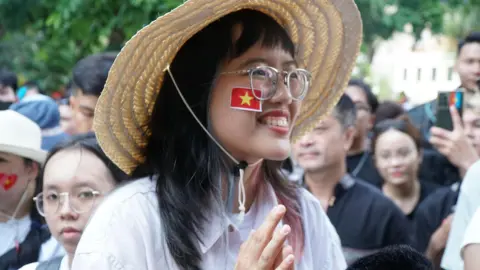In 2025, Vietnam commemorates the 50th anniversary of the end of the Vietnam War, a significant historical event that reshaped the nation’s trajectory. The landscape of Vietnam today stands in stark contrast to the turmoil of the past, characterized by an eagerness for economic growth and a push toward becoming a prominent player in international manufacturing. However, beneath this optimism lies a new challenge, as the country grapples with potential tariffs imposed by the United States, which threaten to hamper its economic ambitions.
Tung Linh, a 20-year-old college student from Ho Chi Minh City, reflects on her limited knowledge of the war, stating that her grandparents’ experiences have allowed her generation to grow in a more peaceful environment. With a small Vietnamese flag sticker adorning her cheek, Linh embodies the youthful spirit of a country in transition, eager for a prosperous future.
Vietnam has undergone remarkable transformations since the war, evolving into a vibrant, capitalist-oriented society that aims to rival its regional neighbors. The government has sought to attract international investment, positioning itself as an alternative to China for manufacturing roles. However, the looming threat of tariffs from the U.S. government, particularly during Donald Trump’s trade war, could undermine these intentions by imposing a hefty 46% levy on imported goods.
Historically, Vietnam has been a strategic battleground, first a French colony, then a site for intense conflict involving American forces, ultimately aimed at stemming the tide of communism throughout Southeast Asia. This complicated legacy fuels a challenging reality today, as Vietnam finds itself situated between the significant influences of the United States and China, a balancing act that has become increasingly complex amid ongoing geopolitical tensions.
Young Vietnamese like Linh, with a median age of just 33 years, embody a shift towards a new generation less consumed by the historical conflicts of their elders. They aspire to careers that contribute to national success, viewed through the lens of modern global trade and economic indicators. Linh articulates a desire to excel in economics and marketing, embodying the ambitions of many of her contemporaries in a city bustling with developments synonymous with any major Asian metropolis.
Ho Chi Minh City, previously known as Saigon, reflects a nation transcending its difficult past. The city features iconic skyscrapers, a diverse economy, and a rapidly growing populace, with Remnants of the war fading from daily conversations. The trauma of the past seems to be overshadowed by optimism for the future, as illustrated by Linh’s sentiments about national reunification.
However, discussions surrounding the war are often stifled by historical sensitivities, particularly evident when young individuals express a desire to engage positively with the United States. Minh, an 18-year-old aspiring lawyer, echoes sentiments of nostalgia for collaboration instead of animosity towards Americans, focusing on globalization and the opportunities it may foster.
As Vietnam’s leadership initiates significant bureaucratic reforms aimed at streamlining processes to promote economic efficiency, noteworthy investments are being made. Measures are being taken to reduce government entities while laying off thousands of employees, showcasing an intent to move towards a more business-friendly environment.
Despite ambitions for growth, the nation is tied to the interplay between the U.S. and China. Companies that fled during the aftermath of the war are being coaxed back into the country, looking to capitalize on favorable investment terms being offered. Lisa Wu, a returnee who has witnessed significant shifts in regional economics, explains that a burgeoning electronics industry is capitalizing on this, especially since the onset of the U.S.-China trade tensions.
Nevertheless, the uncertainty surrounding tariffs remains a pressing concern. As exporters anticipate higher tariffs affecting their operations, many are compelled to pause their investment plans, caught in a predicament where they must choose alliances. Recently, Vietnam extended a warm welcome to Chinese President Xi Jinping, underscoring the delicacy of its evolving relationships.
As Vietnam forges ahead, engaging with both superpowers, it simultaneously looks to build a prosperous future while acknowledging the lessons from its past. Veterans like Le Thanh Gian, despite their scars from the war, emphasize the importance of peace and cooperation, favoring a future where collaboration replaces conflict. The dichotomy of remembering history while striving for progress is a core element shaping the narrative of modern-day Vietnam as it ventures into the global landscape.



